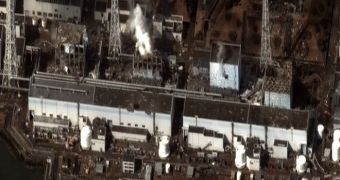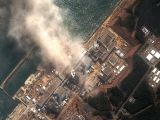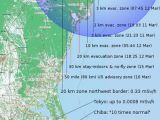According to news reports, Japanese emergency responders have yet to bring reactors 1 to 4 at the Fukushima Daiichi nuclear power plant under control. Additionally, new problems have now developed, including massive levels of radioactive iodine and several leaks.
Reactors 5 and 6 continue to remain in good conditions, whereas the condition of the other four either remained unchanged, or worsened. Investigations conducted at water pools found near reactor #1 has revealed concentrations of radioactive iodine surpassing the legal limit 3355 times over.
The announcement was made earlier today, March 30, by authorities in charge of bringing the reactors under control, Novinite reports. Radiations were also found to be seeping into the sea, next to the four reactors.
At this point, it was determined that reactor #2 is leaking as well. According to the Japanese Nuclear Safety Commission, it could be that some fuel rods inside the containment vessel melted.
The contaminated water then somehow made its way into the unit 2 turbine building basement, via a route that experts have yet to pinpoint. Interventions are made difficult by elevated radiation levels at most locations around the Fukushima Daiichi power plant.
On Saturday, temperatures inside the vessel reached 100 degrees Celsius, but they are now down to 97 degrees C. Utility trenches in the vicinity of the reactors were found to contain radioactive runoff water, as facilities 1 to 3 are being continuously sprayed with water.
This is done to prevent the overheating of nuclear materials inside. Emergency responders have switched to using freshwater instead of seawater, in order to reduce corrosion damage to the reactors.
Authorities are even considering reducing the amount of water they spray on the structure, so as not to help the spread of contaminated runoff water. However, this approach is very risky because it could allow the cores to overheat, and release even more radiations into the atmosphere.
Right now, experts are still working towards bringing cooling and other automated systems back online, but intense radiation at the site is preventing workers from hooking up pump and electrical wires to their respective receptacles.
Chief Cabinet Secretary Yukio Edano also says that responders are considering all options, including covering the first three reactors with sheets of a special material, that is designed to stop the spread of radiation. It's currently unknown whether this option will be pursued.
Earlier today, representatives from the Tokyo Electric Power Company (TEPCO) announced that the four reactors at Fukushima Daiichi will be closed when the crisis is resolved.
A survey that will be conducted among people living in the area will determine the fate of reactors 5 and 6, India Times reports.
The next few days will be critical towards determining the outcome of the crisis, now in its third week.
The most important decision authorities need to make is whether to continue spraying tons of water on the reactors and allow the puddles of radioactive runoff water to grow beyond containment, or to limit the amount of water they spray and risk the cores entering a full meltdown.
Fukushima was brought to its knees by the massive, magnitude 9.0 earthquake that hit Japan more than two weeks ago. The subsequent tsunami caused massive damage of its own, both at the power plant and elsewhere.
When the tremor struck, on March 11, the plant shut down automatically. Control rods came down from the ceilings of the three reactors, and got in between the fuel rods containing radioactive material.
This protection measure functioned flawlessly. However, it only reduces the rate at which radioactive material undergoes nuclear fission. BWR (boiling-water) reactors such as Fukushima's also need active cooling to prevent meltdowns.
This is where things got out of hand. As the tremor hit, the electricity plant providing power to the cooling system pumps was disabled. The next contingency measure kicked in, and the diesel generators began driving said pumps.
About an hour after the earthquake, a large tsunami hit the seaside facility, breaching seawall defenses and damaging the diesel generators as well. The third contingency measure then kicked in. Battery-driven pumps again started driving seawater over the fuel rods in the reactors.
However, there was simply too much residual heat at their cores for these pumps to handle. Steam began building up in excess, and plant operators were forced to vent it into the atmosphere, even if it contained traces of radioactive elements, including iodine and cesium.
But that was not enough either. Explosions started occurring at the reactors because the fuel rods were made of fissionable material encased in the metal zirconium. Reactions between the water and zirconium led to the creation of chemical compounds, including hydrogen.
The three explosions that rocked Fukushima's #1, #2, and #3 reactors were caused when that hydrogen ignited. One of them blew half the roof of reactor #1, but did not destroy the core containment vessel.
Since then, experts have been trying to manage to situation they best they could. Between 170,000 and 200,000 people living around the power plant have been evacuated already.

 14 DAY TRIAL //
14 DAY TRIAL // 

